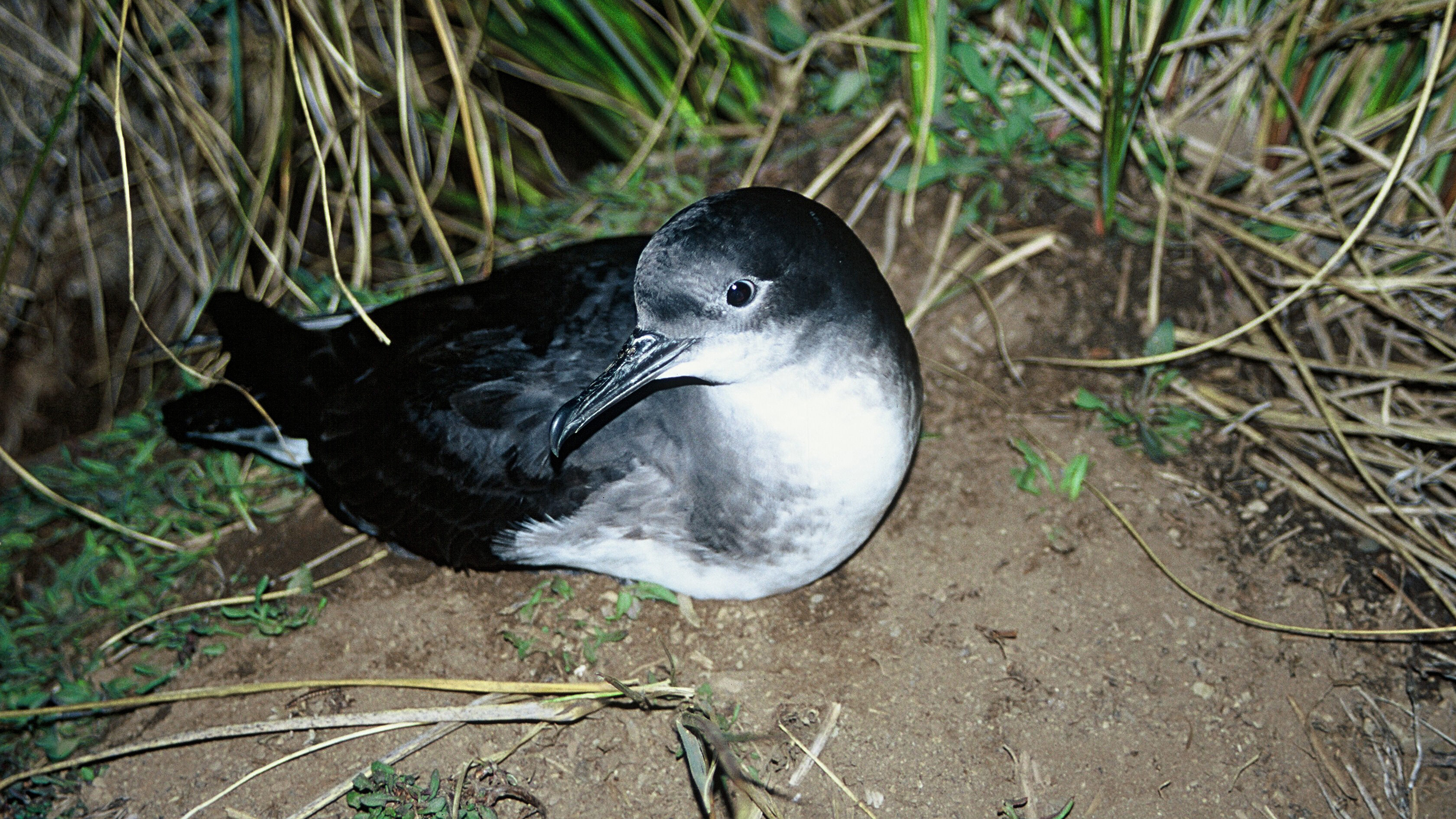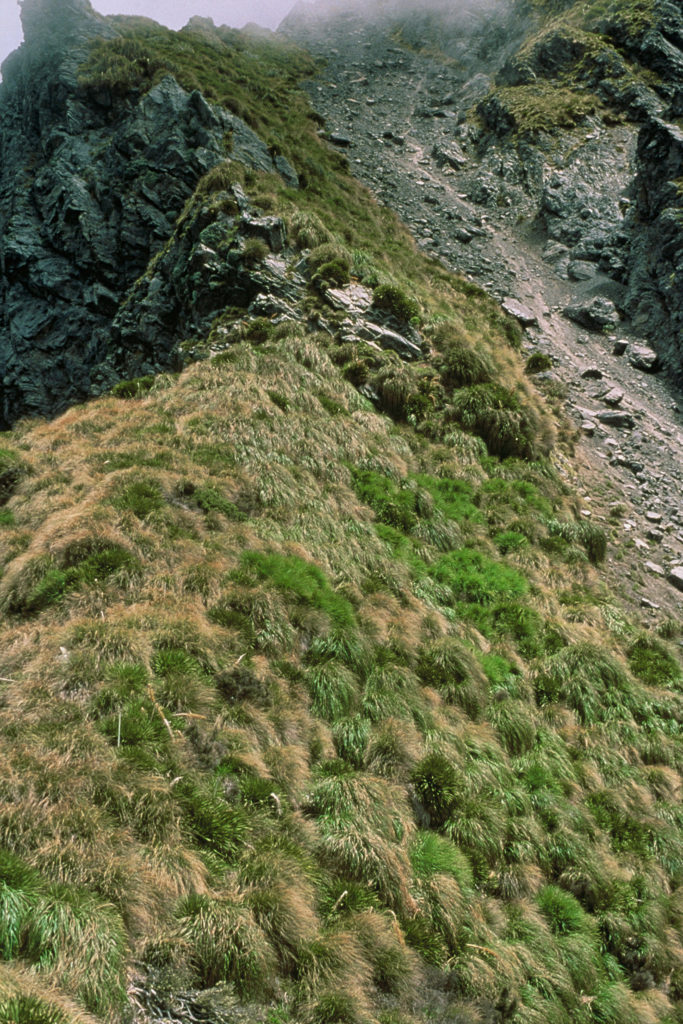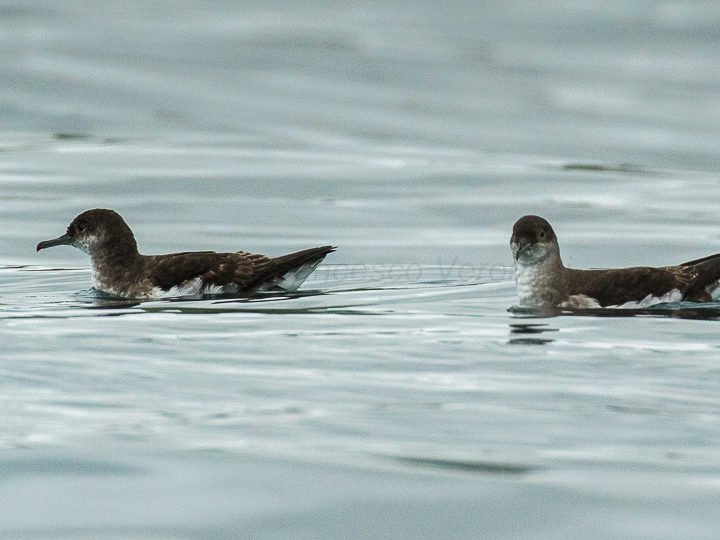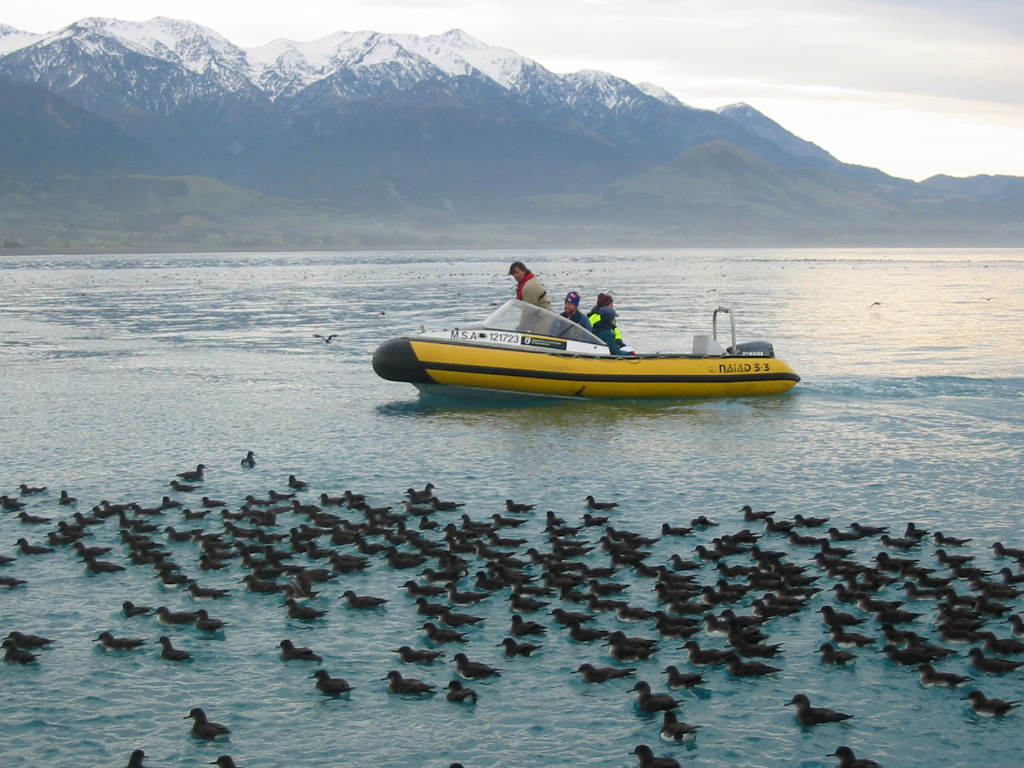The Hutton’s shearwater/Kaikōura tītī (Puffinus huttoni) is the only seabird in the world that breeds in an alpine environment, with breeding colonies in the Seaward Kaikōura Range at elevations between 1200 to 1800 metres.

It’s a strange place to find an ocean bird nesting and explains why the locations of surviving colonies of the Hutton’s shearwater were only ‘rediscovered’ in 1964 by Geoff Harrow. In early times, however, the Hutton’s shearwater/tītī was known to local Māori, providing a major sustainable source of protein to Ngāti Kuri, Tangata Whenua of the area. A number of different shearwater species are known as ‘tītī’ to Māori, particularly during the downy chick stage.
There was little red meat for Tangata Whenua in pre-European times, meaning chicks were a major sustainable food source. Chicks were harvested from their burrows shortly before fledging and preserved in pōhā/kelp bags for up to two years. Those not eaten were traded amongst different Ngāi Tahu hapu for pounamu/greenstone etc. The feathers were also used for clothing and decoration.
The introduction of predators and changes due to land development brought an end to the customary harvest. When the Hutton’s shearwater colonies were rediscovered, there were eight colonies surviving, but only two survive today – on conservation land in the headwaters of the Kowhai River and on private land in Shearwater Stream.

The Hutton’s shearwater is one of the very few New Zealand seabirds that nest only on the mainland, where colonies are accessible to predators, with feral pigs thought to be the main cause of the birds’ decline. Colonies inaccessible to pigs are the only ones to have survived and landslips and earthquakes could make even those colonies accessible in the future. There are no ‘insurance’ colonies of Hutton’s shearwaters breeding on predator-free off-shore islands. In fact, its thought that these seabirds have only ever bred in the Kaikōura ranges and not anywhere else in New Zealand.
Breeding in the mountains when you live and forage for food at sea, brings some challenges for parent birds when it comes to keeping their chicks well-fed.
Colonies are located on steep tussock slopes with deep and friable soil. Birds arriving early in the season may find their colony buried under snow, but later in the season the summer is hot and dry. Burrow density varies, but on average there’s a burrow every half square metre.
The average burrow is 3 metres long. The egg is laid in a hollowed out chamber at the end of the burrow in a nest made of tussock grass and sticks, then lined with feathers.
Peak egg-laying is in early November with a 50-day incubation period followed by an average of 83 days before the chicks fledge. That’s a longer chick-rearing period than found in similar bird species and may be due to difficulties in obtaining sufficient food, or the energetic costs associated with breeding in an alpine environment 1200 m above sea level.
Breeding birds fly in and out of the alpine colonies under cover of darkness. Two recent GPS tracking studies of adults feeding the chicks at the Te Rae O Atiu colony showed that on average birds were going about 200km from the colony and travelling about 800km to do so, over about 4 days. One bird was tracked going over 2,000km on a foraging trip! The birds feed on fish and krill which are later fed to their chicks, on the return flight that means gaining 1,200 m or more in altitude with a belly full of fish.
All the colonies that have gone extinct in the last century have been destroyed by pigs, but that doesn’t mean that pigs are the only predators with a taste for young shearwaters.
Stoats prey on young Hutton’s shearwater chicks, and kea also dig up burrows and kill chicks. Studies have shown that the Kowhai Stream colony is too large to be adversely affected by stoat predation, but stoat control is undertaken at the smaller colony in Shearwater Stream, which is likely to be more vulnerable. Then there are natural disasters.
The Kaikōura earthquakes of November 2016 caused considerable damage to the two alpine colonies. Post-earthquake photographs show that 10-15% of the colonies were destroyed by landslides, and examination of 100 individual burrows at a site not affected by landslides showed that 36% of the burrows had collapsed.
Fortunately, however, there is now a third colony of Hutton’s shearwaters.

Concerns about the vulnerability of the two remaining breeding colonies led to the translocation of young birds and successful establishment of a new colony behind a predator-proof fence on Kaikoura Peninsula. The Hutton’s Shearwater Charitable Trust was formed in October 2008. A predator-proof fence was then constructed in 2010, with further translocations taking place in 2012 and 2013.
According to the Trust, chicks adapted well to their artificial burrows within the predator-proof colony. They were fed sardine smoothies for a 2-3 week period by an army of volunteers, regularly weighed and fitted with metal bands and microchips. During this time the chicks ‘imprinted’ on the site, ensuring they will one day return to the colony to breed. Translocated birds raised at the colony have already begun returning and producing offspring.
There is an estimated breeding population of more than 200,000 pairs of Hutton’s shearwaters, with a similar number of non-breeding birds that visit the colony early in the season. Despite this relatively high number the species is regarded as endangered because of their past decline (evident from extinct colonies) and the threats they still face.
Those threats don’t end when chicks successfully fledge. Like many seabirds, Hutton’s shearwater fledglings are disorientated by bright lights. The artificial lights of Kaikōura, lie in their flight path to sea, resulting in hundreds (if not thousands) crash landing. The Hutton’s Shearwater Charitable Trust promotes a large annual volunteer effort, to save as many grounded birds as possible for release.
At sea, the shearwaters feed only on crustaceans and small fish. They fly close to the water, settling in large flocks (rafts), to feed or rest. Some birds may be dipping at the surface for crustaceans while others pitch in from a low flight to dive for small fish.

A study of diving patterns showed that on average the birds do about 70 dives a day to about 6m lasting about 20 seconds, but some birds do over 300 dives, some to 35m and lasting up to a minute!
Outside the breeding season Hutton’s shearwaters are migratory and most are believed to be absent from New Zealand waters. Adults fitted with geo-locators revealed details of their winter migration to Australia, where birds spend the non-breeding season feeding in warm fish-rich coastal waters, without ever making landfall.
From the moment they take their maiden flight to the ocean, fledglings are totally independent of their parents. They migrate with adult Hutton’s shearwaters to the coastal waters off Australia, where they spend their first 3-4 years until returning to breed in Kaikōura. Adults also make this journey every year but stay only for the non-breeding season (winter).
Ngati Kuri has actively supported tītī conservation and collaborated with the Department of Conservation and Whale Watch to create the artificial insurance colony on the Kaikōura Peninsula.
The name of Ka Whata Tu o Rakihouia Conservation Park, which incorporates the Seaward Kaikoura Ranges and the mountain colonies, comes from Ngati Kuri history and the tītī.

